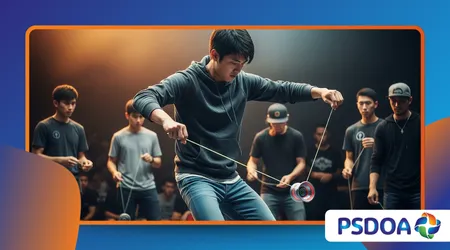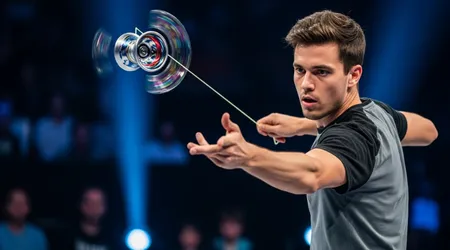The Bizarre World of Competitive Yo-Yo Subculture

The Bizarre World of Competitive Yo-Yo Subculture presents one of the internet’s great paradoxes: a childhood toy transformed into a high-stakes, globally competitive sport demanding precision, athleticism, and artistry.
Anúncios
Far from the image of simple “walk the dog” tricks, modern competitive yo-yoing, or “freestyle,” involves thousand-dollar, precision-machined metal throws, complex choreography, and intricate, fast-paced string maneuvers.
This niche community thrives on innovation and a relentless pursuit of the impossible trick. Observing a World Yo-Yo Contest final is like witnessing a high-tech ballet, where physics battles gravity and the player’s focus is laser-sharp.
The level of technical difficulty achieved by top-tier players is genuinely staggering, redefining the limits of what a revolving piece of plastic or metal can accomplish.
This deep dive uncovers the hidden dedication and surprising technology driving this vibrant, global microculture.
Anúncios
Why is Modern Yo-Yoing a Sport of Extreme Technical Precision?
Dismissing competitive yo-yoing as mere child’s play fundamentally misunderstands the physics and motor skills involved.
It is an art form rooted in mechanics and repetitive, grueling practice, demanding the dexterity of a concert pianist and the endurance of an athlete.
What is the Difference Between Responsive and Unresponsive Yo-Yos?
Modern competitive play centers almost entirely on the “unresponsive” yo-yo. Unlike the traditional responsive model, this yo-yo requires a specialized “bind” maneuver, or a deliberate flick of the wrist, to return to the hand.
This crucial feature allows the yo-yo to “sleep” or spin at the end of the string for minutes at a time, providing the necessary window for long, intricate string tricks without the risk of an untimely return.
The evolution from fixed axles to high-precision ball bearings fundamentally changed the sport, making the most complex Bizarre World of Competitive Yo-Yo Subculture tricks possible.
Moreover, the best competition models utilize bimetal construction, featuring a heavy stainless steel or titanium rim attached to a lightweight aluminum body.
This pushes the weight distribution to the very edges, maximizing rotational inertia for extremely long, stable spin times.
A successful three-minute freestyle routine is a testament to the player’s ability to maintain that spin through dozens of complex manipulations.
++ Vaporwave Architecture: When Design Meets Anti-Capitalism
How Are World-Class Freestyles Judged?
Competitive yo-yo freestyles are meticulously judged across two main categories: Technical Execution (TE) and Freestyle Evaluation (FE). This nuanced system moves far beyond simply counting successful tricks.
The TE score, often worth 60% of the total, assesses the difficulty, risk, and variation of the performed tricks, with judges clicking counters for positive trick elements and deductions for mistakes like string knots or losing spin.
Conversely, the FE score evaluates the routine’s artistry, including choreography, music use, originality, and overall stage presence.
This dual focus ensures champions are not just technical automatons but captivating performers, weaving a narrative through their movements and synchronization with the music.
It truly elevates the competition to a form of performance art, making the Bizarre World of Competitive Yo-Yo Subculture so compelling to watch.

What are the Main Competitive Yo-Yo Divisions?
The competitive landscape is fragmented into five distinct “style” divisions, each requiring specialized equipment and a unique skill set. These divisions demonstrate the sheer diversity achievable with a single toy.
Also read: From Underground to Mainstream: The Lifecycle of Subcultures
Why Does the 1A Division Dominate Competitive Attention?
The 1A (Single A) division, focusing on single, long-spinning unresponsive yo-yos, remains the most popular and technically advanced.
Players perform complex “string tricks,” or “mounts,” creating geometric patterns by landing the yo-yo on different sections of the string.
Routines in this division feature lightning-fast “slacks” (whips of loose string) and “lacerations” (catching the yo-yo in a small loop), often executed so quickly the human eye struggles to follow the action.
Dominating 1A requires not only speed but also flawless consistency under the bright lights of a global stage.
World Champion Mir Kim is known for his signature “Reverse Suicide Ladder,” a high-risk combination of multiple string hops and slack-line releases that few competitors dare attempt.
This level of technical difficulty sets the benchmark for the Bizarre World of Competitive Yo-Yo Subculture.
Read more: Skateboarding as a Cultural Rebellion Then and Now
What Makes the 4A (Off String) and 5A (Freehand) Divisions So Unique?
The 4A, or “Off String,” division involves a yo-yo that is not permanently attached to the string. Players launch and catch the yo-yo in the air, incorporating juggling and acrobatic maneuvers.
It requires immense control and a large open space, feeling more like a circus act than a traditional string trick competition.
The 5A, or “Freehand,” division replaces the finger loop with a counterweight (often a small die or rubber ball).
This introduces a dynamic element where the player can manipulate the counterweight for unique string tension and complex movements, essentially adding a second point of focus to the routine.
The unpredictability of the flying counterweight adds a layer of kinetic chaos that is genuinely captivating.
Comparative Data: Championship Divisions and Focus (World Yo-Yo Contest 2024)
| Division | Yo-Yo Quantity | Attachment Style | Primary Focus | Representative Trick |
| 1A (Single A) | 1 | Attached to Finger | String Tricks (Unresponsive) | The Houdini Mount |
| 2A (Double A) | 2 | Attached to Finger | Looping/Acrobatics (Responsive) | Around the World Variations |
| 3A (Triple A) | 2 | Attached to Finger | String Tricks (Double Unresponsive) | Double Trapeze Combinations |
| 4A (Off String) | 1 or more | Not Attached | Aerial Launches and Catches | The Planet Hoop |
| 5A (Freehand) | 1 | Counterweight | Counterweight and String Manipulation | The Kamikaze Throw |
How Does This Subculture Maintain Authenticity and Growth?
The community remains intensely focused on innovation, which keeps the sport vibrant and authentic, resisting commercial oversimplification.
New tricks and designs circulate rapidly, pushing the entire competitive envelope forward.
Where Does Innovation Come From in This Niche Market?
Innovation is deeply player-driven, with top competitors frequently collaborating with small, specialist manufacturers to design signature yo-yos.
These models, often produced in limited batches, incorporate cutting-edge materials like aerospace-grade aluminum and titanium alloys, reflecting the community’s obsession with performance.
The open-source nature of trick sharing, primarily through YouTube and dedicated online forums, creates a culture of “trick discovery.”
Players build on each other’s work, rapidly evolving the complexity of standard maneuvers. The community truly embodies a spirit of collective mastery. The yo-yo subculture is like a highly specialized, underground Olympic gymnastics event.
The apparatus is deceptively simple, but the routines demand years of unseen, repetitive training to achieve movements that defy standard expectations. The casual observer sees a toy; the devotee sees the rigorous application of physics and art.
What Global Hubs Drive the Competitive Yo-Yo Scene?
While originating in the Philippines and gaining popularity in the US, the competitive scene’s main centers of excellence are now firmly rooted in Asia, particularly Japan and South Korea, which frequently dominate the 1A and 2A divisions.
These regions possess robust local contests, deep mentorship networks, and a strong cultural appreciation for mastery in skill-based arts.
The World Yo-Yo Contest, scheduled for Prague, Czechia in 2025, regularly draws over 300 competitors from 40+ countries, confirming its global, high-level status.
The Bizarre World of Competitive Yo-Yo Subculture truly knows no borders.
What is the Impact of Social Media on Yo-Yo Culture?
Social platforms, especially TikTok and YouTube, have fundamentally changed how yo-yoing is practiced and perceived, shifting it from a niche hobby to an accessible, visually compelling performance art.
The sport’s inherent visual nature is perfect for viral sharing.
How Do Online Videos Fuel the Learning Curve?
YouTube tutorials provide accessible, step-by-step instruction from world champions, democratizing the learning process globally.
A complex trick that once took years to decipher can now be slowed down, looped, and learned in days.
This accessibility has dramatically accelerated the skill level of younger players, with new generations achieving mastery faster than ever before.
Videos of jaw-dropping performances are essential for maintaining the subculture’s relevance, continually attracting new talent into the Bizarre World of Competitive Yo-Yo Subculture.
The global yo-yo market size reached an estimated USD 256 million in 2024, projected to grow at a Compound Annual Growth Rate (CAGR) of 5.2% from 2025 to 2033, driven significantly by the professional and collectibles segments.
This is a direct testament to the community’s demand for high-end gear.
Has the Collector Market Influenced Yo-Yo Design?
Absolutely. The collector market often intersects with the competitive scene. Limited-edition, high-end yo-yos like titanium models or specific bimetal runs can sell out instantly and fetch hundreds, sometimes thousands, of dollars on the secondary market.
This intense demand for collectible “throws” fuels manufacturers’ ability to invest in superior materials and cutting-edge design, pushing the performance limits for all competitors.
The collector’s obsession with rarity directly subsidizes the athlete’s pursuit of technical perfection, creating a virtuous economic cycle.
Conclusion: The Quiet Intensity of the Spinning Toy
The Bizarre World of Competitive Yo-Yo Subculture is a profound testament to human dedication, demonstrating that any object can become the focus of world-class athleticism and art.
These competitors navigate a unique, high-pressure environment, where a single knot or a slight loss of control can destroy a three-minute routine.
By blending precision mechanics with artistic expression, they have transformed a simple toy into a compelling, modern sport.
The quiet intensity, the financial investment, and the sheer skill required demand genuine respect, moving yo-yoing far beyond the nostalgia of the schoolyard.
It’s an authentic, thriving global community. Are we, as a society, too quick to dismiss niche pursuits that hide world-class skill beneath a familiar facade?
Share your thoughts and experiences with unexpected subcultures in the comments below.
Frequently Asked Questions (FAQ)
Why are competitive yo-yos so expensive?
Competitive yo-yos, especially those used by professionals, are expensive because they are precision-machined from high-grade metals like aerospace aluminum (7075 alloy) or titanium.
The costs reflect the complex engineering required to achieve perfect weight distribution, which maximizes stability and spin time essential for complex tricks.
Do yo-yo players get hurt?
Yes, injuries are common, especially in the 4A (Off String) division, where the heavy, fast-spinning yo-yo can strike the player upon an accidental miss.
Minor injuries include string burns and hand bruising, while more serious incidents can involve eye or facial impact from an untethered, high-velocity throw.
What is a “bind” and why is it necessary?
A “bind” is a complex maneuver required to return an unresponsive yo-yo to the hand. The player deliberately creates friction by looping the string around the bearing in a specific way.
It is necessary because unresponsive yo-yos have a gap that is too wide and a bearing that spins too freely to return with a simple tug.
Is there prize money in competitive yo-yoing?
Prize money is generally modest compared to mainstream sports, often ranging from a few hundred to a few thousand dollars for top-tier global events like the World Yo-Yo Contest.
The prestige, sponsorship opportunities from yo-yo manufacturers, and the community’s respect are often considered more valuable rewards than the cash prize itself.
